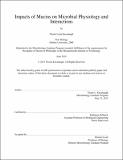| dc.contributor.advisor | Katharina Ribbeck. | en_US |
| dc.contributor.author | Kavanaugh, Nicole Lynn | en_US |
| dc.contributor.other | Massachusetts Institute of Technology. Department of Biology. | en_US |
| dc.date.accessioned | 2015-10-30T18:33:48Z | |
| dc.date.available | 2015-10-30T18:33:48Z | |
| dc.date.copyright | 2015 | en_US |
| dc.date.issued | 2015 | en_US |
| dc.identifier.uri | http://hdl.handle.net/1721.1/99538 | |
| dc.description | Thesis: Ph. D., Massachusetts Institute of Technology, Department of Biology, 2015. | en_US |
| dc.description | This electronic version was submitted by the student author. The certified thesis is available in the Institute Archives and Special Collections. | en_US |
| dc.description | Cataloged from student-submitted PDF version of thesis. | en_US |
| dc.description | Includes bibliographical references (pages 112-113). | en_US |
| dc.description.abstract | The human body is colonized by trillions of microbes known collectively as the microbiota. Many of these organisms inhabit mucosal surfaces, with most found in the large intestines, but many also dwell in the respiratory and urogenital tracts. Despite the enormous microbial population inhabiting the body, some of which are opportunistic pathogens, most people harbor these organisms without showing any signs of disease. The mucus that covers the wet epithelium and houses the microbiota is a prime candidate for offering protection from pathogens, yet its specific role is poorly understood. The object of this thesis is to explore the effects of mucins, the main gel-forming component of mucus, on microbial behavior. Using an in vitro mucus model consisting of purified mucins, I show that these polymers suppress microbial virulence traits in selected bacterial and fungal opportunistic pathogens and influence the composition of microbial communities. In Chapter 2, I study the impact of mucins on bacterial biofilm formation using the opportunistic pathogen Pseudomonas aeruginosa. I demonstrate that mucins reduce surface attached biofilm formation. However, P. aeruginosa can overcome mucin-induced biofilm suppression if flagellar motility is lost, allowing them to form non-surface attached biofilms that are suspended in mucins. In Chapter 3, I analyze the effects of mucins on the virulence traits of Candida albicans, a fungal opportunistic pathogen. The results show that mucins broadly suppress virulence traits of this organism, such as surface attachment, hyphal formation and biofilm formation, at both the levels of gene expression and phenotype. In Appendix A, I combine P. aeruginosa and C. albicans with mucins to determine the influence of these molecules on interspecies interactions. Whereas P. aeruginosa typically kills C. albicans, mucins protect the fungus from bacterial pathogenicity. Therefore, in addition to influencing microbial virulence, mucins can impact microbial community dynamics. Overall, my work suggests that mucins protect the body from microbes by functioning as a modulator of microbial behavior, coercing certain microbes to downregulate virulence gene and trait expression, thereby influencing microbial effects on the host and within the microbiota. | en_US |
| dc.description.statementofresponsibility | by Nicole Lynn Kavanaugh. | en_US |
| dc.format.extent | 113 pages | en_US |
| dc.language.iso | eng | en_US |
| dc.publisher | Massachusetts Institute of Technology | en_US |
| dc.rights | M.I.T. theses are protected by copyright. They may be viewed from this source for any purpose, but reproduction or distribution in any format is prohibited without written permission. See provided URL for inquiries about permission. | en_US |
| dc.rights.uri | http://dspace.mit.edu/handle/1721.1/7582 | en_US |
| dc.subject | Biology. | en_US |
| dc.title | Impacts of mucins on microbial physiology and interactions | en_US |
| dc.type | Thesis | en_US |
| dc.description.degree | Ph. D. | en_US |
| dc.contributor.department | Massachusetts Institute of Technology. Department of Biology | |
| dc.identifier.oclc | 924794954 | en_US |
